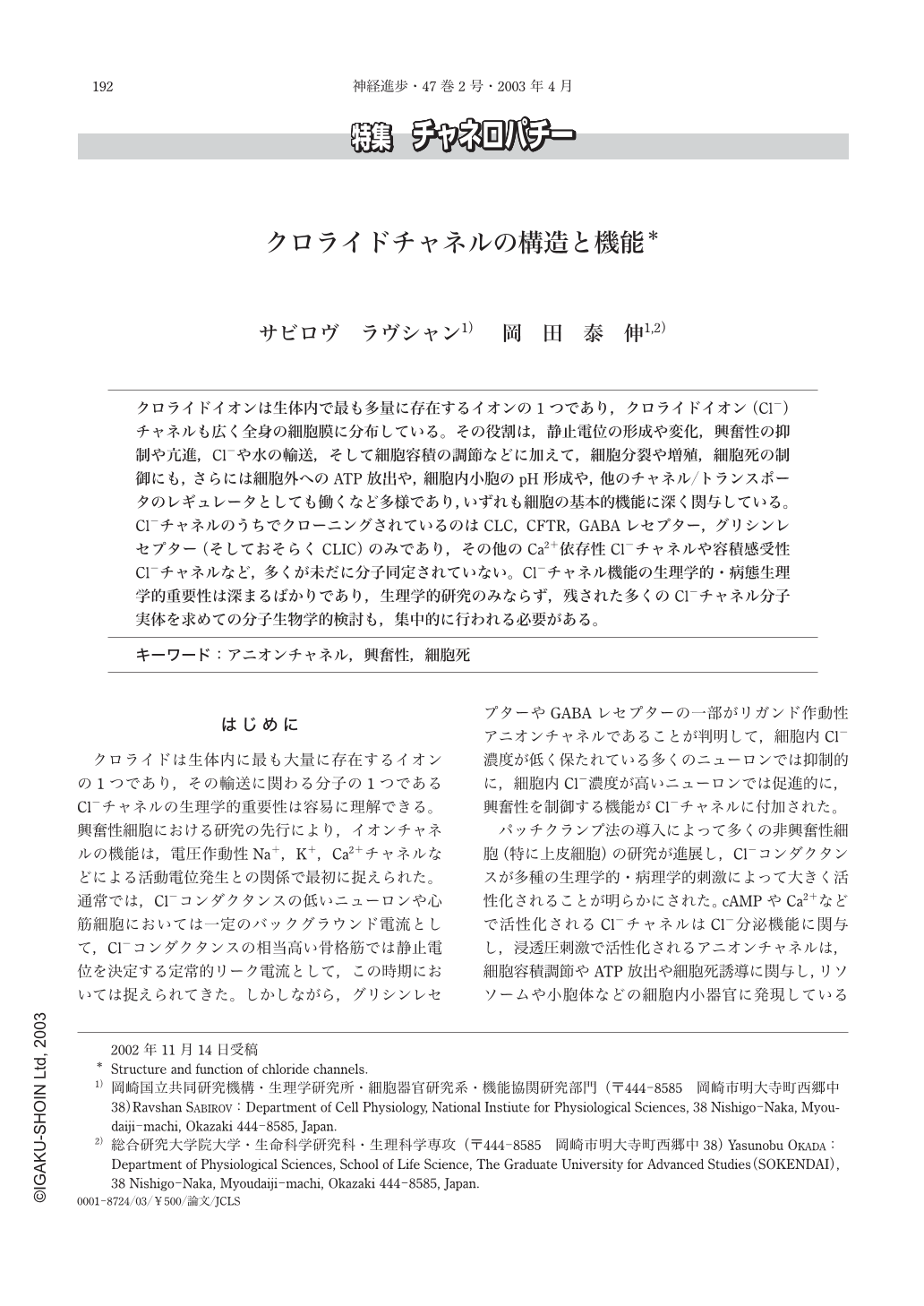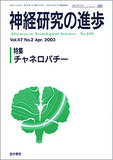Japanese
English
- 有料閲覧
- Abstract 文献概要
- 1ページ目 Look Inside
クロライドイオンは生体内で最も多量に存在するイオンの1つであり,クロライドイオン(Cl-)チャネルも広く全身の細胞膜に分布している。その役割は,静止電位の形成や変化,興奮性の抑制や亢進,Cl-や水の輸送,そして細胞容積の調節などに加えて,細胞分裂や増殖,細胞死の制御にも,さらには細胞外へのATP放出や,細胞内小胞のpH形成や,他のチャネル/トランスポータのレギュレータとしても働くなど多様であり,いずれも細胞の基本的機能に深く関与している。Cl-チャネルのうちでクローニングされているのはCLC,CFTR,GABAレセプター,グリシンレセプター(そしておそらくCLIC)のみであり,その他のCa2+依存性Cl-チャネルや容積感受性Cl-チャネルなど,多くが未だに分子同定されていない。Cl-チャネル機能の生理学的・病態生理学的重要性は深まるばかりであり,生理学的研究のみならず,残された多くのCl-チャネル分子実体を求めての分子生物学的検討も,集中的に行われる必要がある。
はじめに
クロライドは生体内に最も大量に存在するイオンの1つであり,その輸送に関わる分子の1つであるCl-チャネルの生理学的重要性は容易に理解できる。興奮性細胞における研究の先行により,イオンチャネルの機能は,電圧作動性Na+,K+,Ca2+チャネルなどによる活動電位発生との関係で最初に捉えられた。通常では,Cl-コンダクタンスの低いニューロンや心筋細胞においては一定のバックグラウンド電流として,Cl-コンダクタンスの相当高い骨格筋では静止電位を決定する定常的リーク電流として,この時期においては捉えられてきた。しかしながら,グリシンレセプターやGABAレセプターの一部がリガンド作動性アニオンチャネルであることが判明して,細胞内Cl-濃度が低く保たれている多くのニューロンでは抑制的に,細胞内Cl-濃度が高いニューロンでは促進的に,興奮性を制御する機能がCl-チャネルに付加された。
パッチクランプ法の導入によって多くの非興奮性細胞(特に上皮細胞)の研究が進展し,Cl-コンダクタンスが多種の生理学的・病理学的刺激によって大きく活性化されることが明らかにされた。cAMPやCa2+などで活性化されるCl-チャネルはCl-分泌機能に関与し,浸透圧刺激で活性化されるアニオンチャネルは,細胞容積調節やATP放出や細胞死誘導に関与し,リソソームや小胞体などの細胞内小器官に発現しているCl-チャネルは,プロトンポンプによるH+輸送やCa2+遊離チャネルによるCa2+放出を(電気的中性を保つ上で必要なCl-輸送路を保つことによって)サポートする役割を果たしている。このようなCl-チャネルの新しい諸機能の多くは,興奮性細胞においても共有されていることが次々に明らかにされはじめている。
遺伝子クローニング法の導入によって,多くのチャネル蛋白のアミノ酸配列が明らかとなった。しかしアニオンチャネルでクローニングされているのは,リガンド作動性アニオンチャネルに分類されるグリシンレセプター,GABAAおよびGABACレセプターとcAMP依存性Cl-チャネルのCFTR,そして電圧依存性Cl-チャネルと細胞内小器官アニオンチャネルの両方に分類されるCLCチャネルと,細胞内小器官アニオンチャネルのCLICとVDACである。その他の多くの重要なアニオンチャネル,例えばCa2+依存性Cl-チャネルや容積感受性Cl-チャネルなどは,未だにクローニングされていない。
Chloride is a most abundant ion in living bodies. Cl-channels are expressed in most cell membranes and involved in fundamental cell functions. The roles of Cl-channel include formation of resting potential, modulation of electrical excitability, transport of electrolytes and fluid, cell volume regulation, cell growth control, cell death induction, ATP release, control of H+and Ca2+transport in organelles, regulation of other channels and transporters, etc. Although the genes of CLC, CFTR, GABA receptor and glycine receptor have been cloned, the molecular identities of a number of other anion channels, including volume-sensitive Cl-channel and Ca2+-activated Cl-channel, have not been determined as yet. Since physiological or pathophysiological significance of anion channels have become increasingly important, intensive studies are further required for molecular identification of these anion channels as well as for their structural and functional understanding.

Copyright © 2003, Igaku-Shoin Ltd. All rights reserved.


